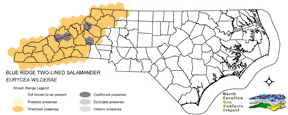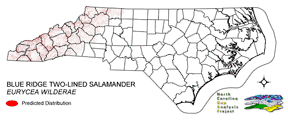
| Taxa: |
| Order: |
| Family: |
| Amphibia |
| Caudata |
| Plethodontidae |
| NatureServe Global Rank: |
| NatureServe State (NC) Rank: |
| G5 |
| S5 |
| Federal Status: |
| NC State Status: |
| --- |
| --- |


| Land Unit |
| US Fish & Wildlife Service |
| US Forest Service |
| US National Park Service |
| US Department of Defense |
| NC State Parks |
| NC University System |
| NC Wildlife Res. Com. |
| NC Forest Service |
| NC Div. of Coastal Mgmt. |
| Local Governments |
| Non-Governmental Org. |
| Other Public Lands |
| Private Lands |
| GAP Status 1-2 |
| All Protected Lands |
| Statewide |
| Hectares |
| 0.00 |
| 63,407.79 |
| 59.94 |
| 25,086.24 |
| 1,571.40 |
| 14.04 |
| 2,016.18 |
| 451.47 |
| 0.00 |
| 1,312.47 |
| 1,568.34 |
| 3.15 |
| 184,334.22 |
| 35,925.15 |
| 95,412.36 |
| 279,825.24 |
| Acres |
| 0.00 |
| 156,684.03 |
| 148.11 |
| 61,989.44 |
| 3,883.01 |
| 34.69 |
| 4,982.09 |
| 1,573.00 |
| 0.00 |
| 3,243.18 |
| 3,875.45 |
| 7.78 |
| 455,499.69 |
| 89,230.35 |
| 236,226.42 |
| 691,920.48 |
| % of Dist. on |
| Prot. Lands |
| 0.0 % |
| 66.5 % |
| < 0.1 % |
| 26.3 % |
| 1.6 % |
| < 0.1 % |
| 2.1 % |
| 0.5 % |
| 0.0 % |
| 1.6 % |
| 1.6 % |
| 0.0 % |
| 0.0 % |
| 37.7 % |
| ----- |
| ----- |
| % of Dist. on |
| All Lands |
| 0.0 % |
| 22.7 % |
| < 0.1 % |
| 9.0 % |
| 0.6 % |
| < 0.1 % |
| 0.7 % |
| 0.2 % |
| 0.0 % |
| 0.5 % |
| 0.6 % |
| < 0.1 % |
| 65.9 % |
| 12.8 % |
| ----- |
| ----- |
|
Found throughout the southern Appalachian region, from southwestern Virginia to northeastern Georgia (Wilson 1995). This species is associated with small flowing waters (Wilson 1995). Will venture away from water and reside in mesic situations on the forest floor. NATURE SERVE GLOBAL HABITAT COMMENTS: Rocky brooks, springs, seepages; may disperse into terrestrial habitats in wet warm weather. Adults hide under objects in or near water. Eggs are laid in water on underside of rock, log, etc. |
| Code | Name | Description | NC Natural Heritage Program Equivalent |
| 238 | Piedmont/Mountain Submerged Aquatic Vegetation | Seasonally to permanently flooded areas with aquatic vegetation. Waterlily, pondweed, hydrilla smartweed are a few of the species that can occur. | Piedmont/Mountain Semipermanent Impoundment (in part) |
| 239 | Piedmont/Mountain Emergent Vegetation | Emergent vegetation of all wetland hydrologies. Sites would commonly support species such as tussock sedge, rushs, and cattail alliances. | Rocky Bar and Shore (in part) |
| 267 | Riverbank Shrublands | Riverside shrubs with temporarily flooded hydrologies. Found in the both the Mountains and Piedmont. Containing dominants such as smooth alder and a Carolina or black willows. | Sand and Mud Bar |
| 269 | Floodplain Wet Shrublands | Saturated shrublands of the Piedmont, includes buttonbush, swamp-loosestrife, decodon and alders. | Piedmont/mountain Semipermanent Impoundment |
| 230 | Piedmont Mesic Forest | American Beech - Red Oak - White Oak Forests. | Mesic Mixed Hardwood |
| 384 | Piedmont/Mountain Mixed Bottomland Hardwood Forests | Includes temporarily to seasonally forests dominated by hardwood species. Hardwoods include sweetgum, red maple, sycamore which co-occur in a mosaic of bottomland and levee positions. Includes alluvial hardwood forests in the mountains. Hemlock and white pine may occur as inclusions, but are generally mapped separately. | Piedmont/Mountain Alluvial Forest, Piedmont/Mountain Levee Forest |
| 383 | Piedmont Mixed Successional Forest | Generally loblolly mixed with successional hardwoods. Sweetgum, tulip poplar and red maple are common co-dominants in these successional forests. | No equivalent |
| 8 | Open water | Open water without aquatic vegetation. | No equivalent |
| 517 | Hemlock Floodplain Forest | Alluvial forest with hemlock and/or white pine in mountains and western piedmont. Hydrology is generally temporarily to seasonally flooded. | Canada Hemlock Forest |
| 521 | Spruce/Fir Forest | High Elevation Frazer-Fir - Red Spruce, Red Spruce and Red-Spruce-Yellow Birch Forests. Tree densities included here include both woodland to forest density. Highly intermixed with Northern Hardwoods, Grassy Balds, and Shrub Balds. | Red Spruce--Fraser Fir Forest, Fraser Fir Forest |
| 522 | Northern Hardwoods | High Elevation forests including yellow birch, American beech, and yellow buckeye. Includes forests with Hemlock and Yellow Birch. | Northern Hardwoods Forest, Boulderfield Forest |
| 526 | Appalachian Cove Forest | Mixed Mesophytic forests of the mountains. Includes tuliptree, basswood, yellow buckeye and surgar maple. This class is mapped to include cove forests dominated or co-dominated by hemlock. | Rich Cove Forest, Acidic Cove Forest |
| 527 | Appalachian Hemlock | Upland hemlock forests of the moutains region. Vary from side slopes to steep slope positions. | Canada Hemlock Forest |
| 533 | Appalachian Swamp Forest | Evergreen and deciduous forests with saturated hydrologies. This class may contain a variety of trees species, including hemlock - red maple, pitch pine, and white pine forests. | Swamp Forest-Bog Complex, Southern Appalachian Bog, Southern Appalachian Fen |
| 534 | Appalachian Wet Shrubland/ Herbaceous | Saturated shrubs and herbaceous vegetation. Often mapped as an inclusion in Appalachian Swamp Forest. | Southern Appalachian Bog, Southern Appalachian Fen |
|
Mittleman, M. B. 1966. EURYCEA BISLINEATA. Cat. Am. Amph. Rep. 45.1-45.4.
Petranka, J. W., M. E. Eldridge, and K. E. Haley. 1993. Effects of timber harvesting on southern Appalachian salamanders. Conservation Biology 7(2):363-370. Wilson, L. A. 1995. The Land Manager's Guide to the amphibians and reptiles of the South. Chapel Hill, NC: The Nature Conservancy. Bruce, R. C. 1985. Larval period and metamorphosis in the salamander EURYCEA BISLINEATA. Herpetologica 41:19-28. Jacobs, J. F. 1987. A preliminary investigation of geographic genetic variation and systematics of the two-lined salamander, EURYCEA BISLINEATA (Green). Herpetologica 43:423-446. |
For more information please contact them at:
NC-GAP Analysis Project
Dept. of Zoology, NCSU
Campus Box 7617
Raleigh, NC 27695-7617
(919) 513-2853
www.basic.ncsu.edu/ncgap